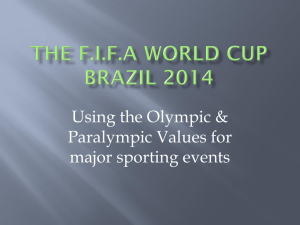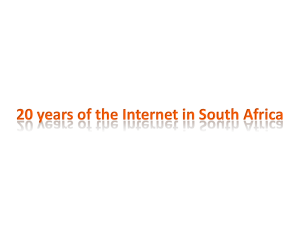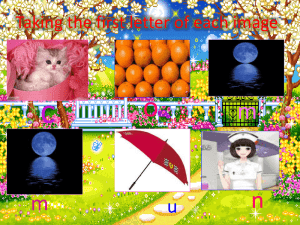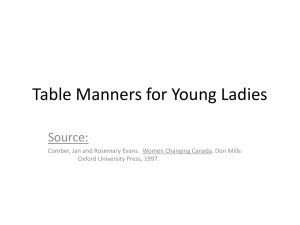Football 1955-1974
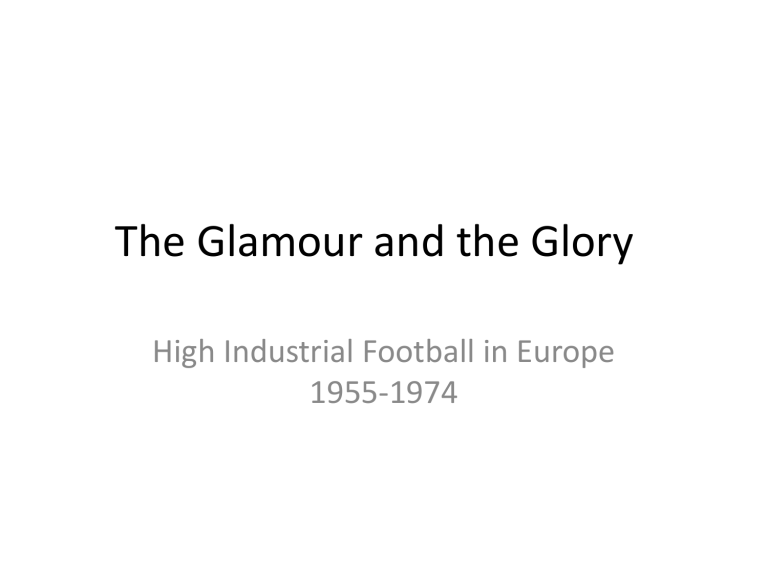
The Glamour and the Glory
High Industrial Football in Europe
1955-1974
Changes in Football in the late 50searly 60s
• ILLUMINATION (Artificial Light)
• The game was transformed by the process of European integration that produced the UEFA Cup and the
European Cup (new dramatic form of European competition).
• The GAME WAS WIDELY TELEVISED (initiating a change in the game economics and relation with culture and celebrity): “it transformed a collective experience and memory of the game).
• The FOOTBALL OF AFFLUENCE, the football of Europe as a highly industrialized continent leading to more money, new methods and styles of play and glamour.
FOUNDATION OF UEFA
• The Foundation of Union des Associations
Européennes de Football in 1954 and the creation in
1955 of the first European Competition (European
Champions Cup) marked a DECISIVE BREAK IN THE
ORGANIZATION OF EUROPEAN FOOTBALL.
• You must regard it as the reaction to the lost of power of European states in FIFA (as for instance South
American states had already achieved football union in
1916) due to post-colonial politics (MORE STATES
FREEING FROM THE COLONIAL YOKE)
• Regard it as the counterpart to the Schumann
Declaration which in 1950 led to pool coal and steel production of France and Germany
• Idea of European cooperation and integration which later developed in the Treaty of Rome which established the European Economic
Community in 1960.
• There had been European and International
Football competitions already. For instance the
Mitropa Cup or the Copa Latina (see later), but when in 1954 Wolverempton Wonderers beat
Honved in a pitch deliberately saturated with water on the orders of the English manager Stan
Cullis, the idea of a unified and fully-fledged tournament played in the floodlights in mid-week
(to fit in the domestic schedule) gained momentum.
THE ORIGINS OF THE INTER-
EUROPEAN FOOTBALL
• The first "international" competition for football clubs was founded in 1897 in Vienna.
• The CHALLENGE CUP was invented by John
Gramlick Sr., a co-founder of the Vienna Cricket and Football Club. In this cup competition all clubs of the Austro-Hungarian Empire that normally would not meet could take part, though actually almost only clubs from the Empire's three major cities Vienna, Budapest and Prague participated.
THE AUSTRO-HUNGARIAN EMPIRE
• The CHALLENGE CUP was carried out until the year 1911 and is today seen as the predecessor to the Mitropa Cup.
• The last winner of the cup was Vienna Sports
Club, one of the oldest and most traditional football clubs of Austria where the cup still remains.
THE FIRST
WINNER:
FC FIRST
WIEN, 1899
MITROPA CUP
• Officially called the La Coupe de l'Europe
Centrale, was one of the first international major European football cups for club sides.
After World War II in 1951 a replacement tournament named Zentropa Cup was held; the Mitropa Cup name was later revived, but the tournament declined and was discontinued after 1992.
• The idea of a European cup competition was shaped after World War I which brought the defeat and collapse of the Austro-Hungarian Empire.
• The centre of this idea were the Central European
countries that, at this time, were still leading in continental football.
• In the early 1920s they introduced professional
leagues, the first continental countries to do so.
Austria started in 1924, followed by Hungary in 1925 anD Czechoslovakia in 1926.
• In order to strengthen the dominance of these countries in European football and to financially support the professional clubs, the introduction of the
MITROPA CUP was decided at a meeting in Venice on
17 July
• The competition was between the top
professional teams of Central Europe.
• Initially two teams each from Austria, Hungary,
Czechoslovakia and Yugoslavia entered, competing in a knock-out competition. The countries involved could either send their respective league winners and runners-up, or league winners and cup winners to take part.
• The first winners were the Czech side, AC Sparta
Prague.
• In 1929 Italian teams replaced the Yugoslavian ones
• he competition was expanded to four teams from each of the competing countries in 1934.
Other countries were invited to participate -
Switzerland in 1936, and Romania,
Switzerland and Yugoslavia in 1937.
• he level of the competing nations is clearly shown by Italy's two World Cup titles (1934 &
1938), Czechoslovakia's (1934) and Hungary's
(1938) World Cup final, and Austria's (1934) and Yugoslavia's (1930) semi-finals.
• A tournament was started in 1940, but abandoned before the final match due to World War II.
• After World War II, the cup was resumed in 1951, initially as Zentropa Cup.
• The Cup, once again named Mitropa Cup, lost much of its status because of the introduction of other
European club competitions, and faced an ongoing decline.
• By the 1980s it was competed for between the second
division champions of the participating countries.
• It was last played for in 1992, and won by Yugoslav side Borac Banja Luka in front of fewer than a thousand spectators.
COPA LATINA
• It was an international football tournament for club sides from the Latin European nations
of France, Italy, Spain and Portugal, launched
In 1949.
• As European clubs could not afford heavy travel costs the competition was staged at the end of every season in a single host country.
• The competition featured two semi-finals, a third place play-off and a final.
• The competition was last played for in 1957, following the introduction of the European
Cup.
• Real Madrid played and won in both the
European Cup and the Latin Cup in 1957.
• Immediately prior to the introduction of the
European Cup, the Latin Cup was considered the most important cup for clubs in Europe.
Back to UEFA…
• Over the period 1955 (first game of the new competition Sporting Lisbon vs Partizaz Belgrade)
-1974 UEFA organized not only the EC and but also the European Cup Winners’ Cup and the
Inter-City Fairs (later known as UEFA cup).
• By far the most important tournament was indeed the EC : the history of football of this era cannot be written without the fate of this tournament and the succession of teams that won it
EUROPEAN CUP
• Illuminating Geography: from 1956 all the finalists
(with the exception of Eintracht Frankfurt) came from the Western Mediterranean (Partizan Belgrade the first team to break this spell of dominance when they lost in 1966 final 1966).
• Iberian Peninsula the real superpower (Real Madrid winning five cups in a row from 1956 to 1960 and a sixth in 1966 to be followed by Benfica).
• English teams not part of the competition at the beginning.
TELEVISION
• Football as visual art and television (by then in its infancy) allowed the art to be admired by many people.
• Introduction of broadcasting and recording transformed the historical record.
• One must consider that –before TVthe limited number of cameras at matches have left us only with fragments: scrap of goals from the oddest angles.
• Consequently the memory of football was dependent on radio (and little on reportage and photographies): as a consequences the greatest players (Pichichi,
Andrade, Scarone, Mazzola, Piola) were barely known.
• With Television players came to prominence as a collective phenomenon: Eusebio, Rivera, Bobby
Charlton, Best, Beckenbauer, Cruyff, and Pele
(with the latter being the only one at the edge of two eras).
• The key innovators in football coverage were the
British with the BBC developing extensive sport coverage from 1960s on (think that in 1954 only 9 games of the 1954 were broadcasted as the first game broadcasted across the whole was the EC
1960 Final between Real Madrid and Eintracht); however, the Italians came up with the first TV program sport show in 1954 (LA DOMENICA
SPORTIVA, 1954) and the Germans were the first to sell TV rights of matches.
• Another big change came with the introduction of the SLOW MOTION REPLAY (a consequence of the invention of VTR machines) also known as MOVIOLA.
• First experimented in La Domenica Sportiva, it soon became central to post-match analysis and allowed the creation of conspiracies and controversies. This in turn led to the introduction of a
• panel of commentators and football personalities to analyze the game.
• Another change came with the introduction of colour television.
• Impact of Television on Football Finances remained marginal (until Murdoch’s advent in 1990s). In the absence of commercial television outside Britain value of TV rights could not be inflated.
• Although TV was eating into football’s audience, attendance declined but did not collapse as match-day ticket sales remained the main source of revenue for clubs
• However, TV created moments of collective experience as England’s victory in the World Cup in
1966 was watched by 15 million and when Italy played in 1970 final 17 million of Italians were watching
• This contributed to the creation of powerful moments of imagined community in post-war Europe for nations to gather the meaning of their own identity.
LONG WAVE OF ECONOMIC GROWTH
IN EUROPE (late 1950S-early 1970S):
THE FOOTBALL OF AFFLUENCE
• Ushered in by an era of international stability and domestic peace.
• What distinguished the football in this period were
NOT the technologies (flood-light and TV were invented before WW2) NOR the bots, balls, (the first football made of artificial materials was introduced in
1974) pitches (artificial grass only in the US), kits or stadiums (reinforced concrete and steel cantilevers were already in use in the 1930s as showed in the
Olympic Stadium of Montevideo) NOR –if you like- THE
ISE OF MUSCLE BUILDING STEROIDS BASED ON OLDER
FARMACEUTICAL TECHNOLOGIES.
• WHAT DISTINGUISHED FOOTBALL OF AFFLUENCE WAS
THE TFACT THAT ALL THESE INNOVATIONS WERE
BROUGHT TOGETHER AND MADE ACCESSIBLE TO
CLUBS UNDER CONDITIONS OF BETTER
INTERNATIONAL ORGANIZATION AND
PROFESSIONALISM.
• Words like Public Relations or Management at Board
Level became more and more popular as the Italians first introduced the labor division: wealthy president/technical director (dealing with transfers, organization and logistics) and a coach.
• This also led to the creation of a generation of players who were fitter, healthier and acquired more longevity as they also became glamour stars.
GEORGE BEST
• The “fifth Beatle”
• Played as a winger for Manchester United and the Northern Ireland national team. In 1968 he won the European Cup with United, and was named the European Footballer of the Year and
FWA Footballer of the Year.
• He is described by the national team's governing body, the Irish Football Association, as the
"greatest player to ever pull on the green shirt of
Northern Ireland".
GIANNI RIVERA
• An Italian football midfielder, mostly as an offensive playmaker, who was awarded the
Ballon d'Or
• An elegant and efficient playmaker, mostly known for his dribbling skills and vision.
• Played most of his career for AC Milan
GLORY IN HIGH INDUSTRIAL
FOOTBALL?
• Football was more rationalized and professionalized than commercialized.
• Innovations of the era where coaching, training, tactics, internal organization rather than acquisition of new stream of revenues.
• Although there was more money in the game and more glamour (courtesy of TV), football remained a cottage industry as only few leading superstars were paid more than average working class
• Advertisement and branding were invented as late as 1973.
• UEFA AND FOOTBALL acting as a real pan european institutions bringing together the two halves of the continent and helping to integrate its Western part after the tragedies of WW2
